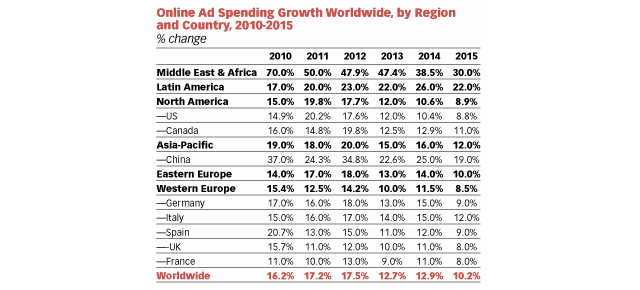P&G CEO Ad Spend Moving Online to Reach Emerging Markets

Source: eMarketer
In Procter & Gamble’s (NYSE:PG) earnings update last month, CEO Robert McDonald highlighted that the advertising expenditure will continue to be around 10% of the company’s sales and will include a greater share of online advertising with a continued focus on the emerging markets. P&G mainly competes with consumer products companies like Unilever (NYSE:UL), Colgate-Palmolive (NYSE:CL) and Kimberly-Clark (NYSE:KMB). Below we explore how the growing online advertising industry benefits P&G.
Strong Potential in Online Advertising
Internet penetration has been rising at a staggering pace in emerging markets. While North America leads with a 77% Internet penetration, Asia with its huge population has a penetration of only 22%. [1] Asia witnessed 6x increase in the number of Internet users in the last decade and despite the low penetration — almost 42% of the world’s Interest users reside here. This underscores the room for growth from Asia alone, which P&G is targeting.
- Should You Pick Procter & Gamble Stock At $155 After A Mixed Q2?
- Is Procter & Gamble Stock Fully Valued At $150?
- Will Procter & Gamble Stock Continue To Rise After 27% Gains In The Ongoing Inflation Shock?
- Should You Buy TMUS Over Procter & Gamble Stock For Better Returns?
- Should You Buy Colgate-Palmolive Stock At $80?
- Here’s A Better Pick Over Procter & Gamble Stock
In a post-earnings conference call, Robert McDonald highlighted that the advertising spend will continue to be around 10% of sales, which alleviates our concerns with regards to the operating margin being strained further to meet the demand for new product launches. However, P&G intends to reallocate the advertising budget among different media with advertising over the Internet gaining prominence in the future. [2]
Online Advertising More Audience-Driven
Digital advertising is more focused in terms of reaching audience. Facilitated by search engine advertising and social networking websites such as Facebook and Twitter, advertisers are able to reach a more relevant audience. For example, a teenager is more likely to see a Gillette razor advertisement than an Olay anti-aging skin care on the websites he visits. Whether these digital impressions translate into sales and that digital advertising is more cost-effective is open to discussion, but then so is advertising on any other medium.
We currently forecast the EBITDA margin to decline amid rising selling, general and administrative (SG&A) expenses. As P&G embraces a more digital advertising strategy, we can reasonably expect the margins to hold despite P&G’s expansion into newer markets. You can drag the chart above to see the impact on P&G’s stock.
See our full analysis for Procter & Gamble.
Notes:- Internet Usage Statistics, Internet World Stats [↩]
- P&G Champions Digital, Warc.com, May 02, 2011 [↩]
